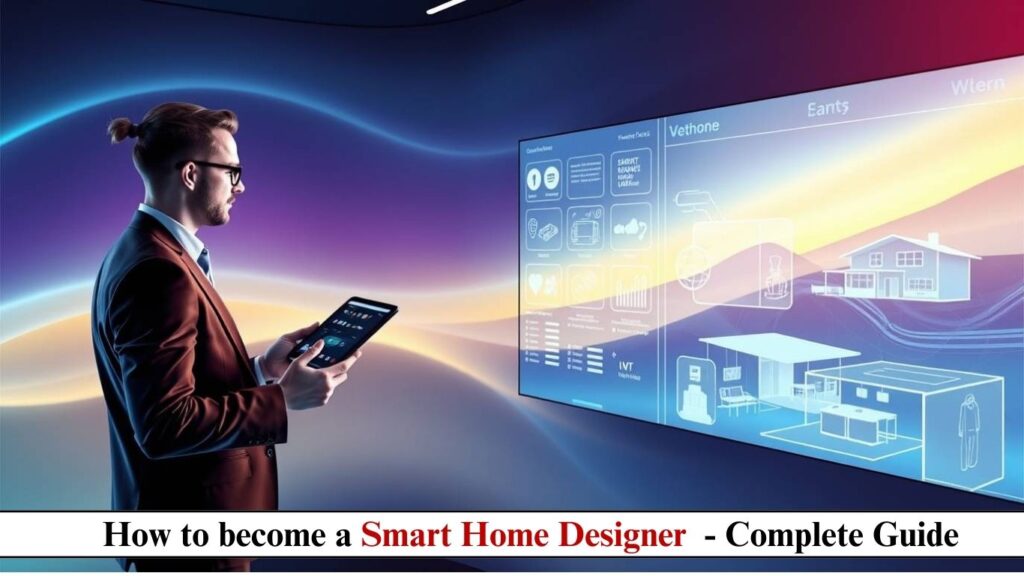
Introduction
The smart home industry is booming, with homeowners and businesses embracing automation for convenience, security, and energy efficiency. A Smart Home Designer specializes in creating integrated, intelligent living spaces by selecting and configuring IoT (Internet of Things) devices, automation systems, and energy-efficient solutions.
This comprehensive guide covers:
✔ History of smart home technology
✔ Salary expectations & career growth
✔ Roles & responsibilities
✔ Required qualifications & skills
✔ How to get started
✔ Future trends & opportunities
History of Smart Home Technology
Smart homes have evolved from simple automation to AI-driven ecosystems.
Key Milestones in Smart Home Evolution:
- 1975: X10 protocol introduced, enabling remote control of home appliances.
- 1999: The term “smart home” gains popularity with early home automation systems.
- 2007: Nest Labs launches the first smart thermostat, revolutionizing energy management.
- 2014: Amazon Echo introduces voice-controlled smart assistants.
- 2020s: AI-powered smart homes integrate with IoT, 5G, and edge computing.
Today, smart homes feature automated lighting, security, climate control, and AI-driven personalization.
Smart Home Designer Salary
Salaries vary based on experience, location, and specialization.
Average Salary Ranges (Annual):
| Experience Level | Salary Range |
|---|---|
| Entry-Level (0-2 yrs) | $50,000 – $80,000 |
| Mid-Level (3-5 yrs) | $80,000 – $120,000 |
| Senior-Level (5+ yrs) | $120,000 – $180,000+ |
Top-Paying Industries:
- Luxury Home Automation – $90K-$150K
- Commercial Smart Buildings – $100K-$160K
- IoT Product Development – $110K-$170K
- Energy Management Consulting – $85K-$140K
Freelance designers charge $50-$200/hour for custom installations.
Roles & Responsibilities
A Smart Home Designer bridges technology, architecture, and user experience.
Core Responsibilities:
- Consultation & Needs Assessment
- Evaluate client requirements (security, energy efficiency, convenience).
- Recommend smart lighting, HVAC, security, and entertainment systems.
- System Design & Integration
- Select compatible devices (e.g., Google Home, Philips Hue, Ring, Ecobee).
- Design centralized control hubs (Control4, Savant, Crestron).
- Installation & Configuration
- Set up Wi-Fi, Zigbee, or Z-Wave networks.
- Program automation routines (e.g., “Good Morning” scene).
- Testing & Troubleshooting
- Ensure seamless device connectivity.
- Debug issues with voice assistants, sensors, or cameras.
- User Training & Documentation
- Educate homeowners on app controls & voice commands.
- Provide maintenance guides.
Qualifications & Skills Needed
Education & Certifications:
- Bachelor’s Degree in:
- Electrical Engineering
- Computer Science (IoT focus)
- Interior Design (Smart Home Integration)
- Certifications:
- CEDIA (Custom Electronic Design & Installation Association) Certification
- KNX Partner (Smart Building Standard)
- Amazon Alexa/Google Home Developer Certification
Technical Skills:
✔ IoT Protocols: Wi-Fi, Zigbee, Z-Wave, Matter
✔ Home Automation Platforms: Home Assistant, SmartThings, Hubitat
✔ Electrical Basics: Wiring, circuit design, low-voltage systems
✔ Programming: Python for automation scripts
Soft Skills:
✔ Problem-solving for device compatibility issues
✔ Customer service for client consultations
✔ Creativity in designing seamless user experiences
How to Get Started as a Smart Home Designer
Step 1: Learn the Basics
- Take free courses on IoT and home automation (Udemy, Coursera).
- Experiment with DIY smart home kits (Raspberry Pi, Arduino).
Step 2: Gain Hands-On Experience
- Install smart bulbs, plugs, and cameras in your own home.
- Volunteer for smart home projects (friends, local businesses).
Step 3: Build a Portfolio
- Document case studies (before/after automation setups).
- Showcase projects on LinkedIn or a personal website.
Step 4: Get Certified
- Obtain CEDIA or KNX certification for credibility.
- Specialize in voice control or energy management.
Step 5: Market Your Services
- Offer free smart home audits to attract clients.
- Partner with real estate agents & interior designers.
Future of Smart Home Design
Emerging Trends:
- AI-Powered Predictive Automation
- Homes that learn routines (e.g., adjusting temps before you arrive).
- Matter Protocol Adoption
- Unified standard for cross-brand device compatibility.
- Energy-Efficient Smart Grids
- Homes integrating with solar panels & battery storage.
- Health Monitoring Homes
- Sensors detecting air quality, sleep patterns, and emergencies.
Industries to Watch:
- Senior Living: Smart homes for elderly care & safety.
- Rental Properties: Landlords adopting keyless entry & energy savings.
- Smart Cities: Connected homes as part of larger IoT ecosystems.
Conclusion: Is Smart Home Design Right for You?
If you love technology, problem-solving, and improving lifestyles, this career offers high demand and growth potential.
Next Steps:
- Experiment with smart devices at home.
- Get certified in CEDIA or KNX.
- Start small with local clients.
The future of living is smart—will you help design it? 🚀💡🏠













Post Comment